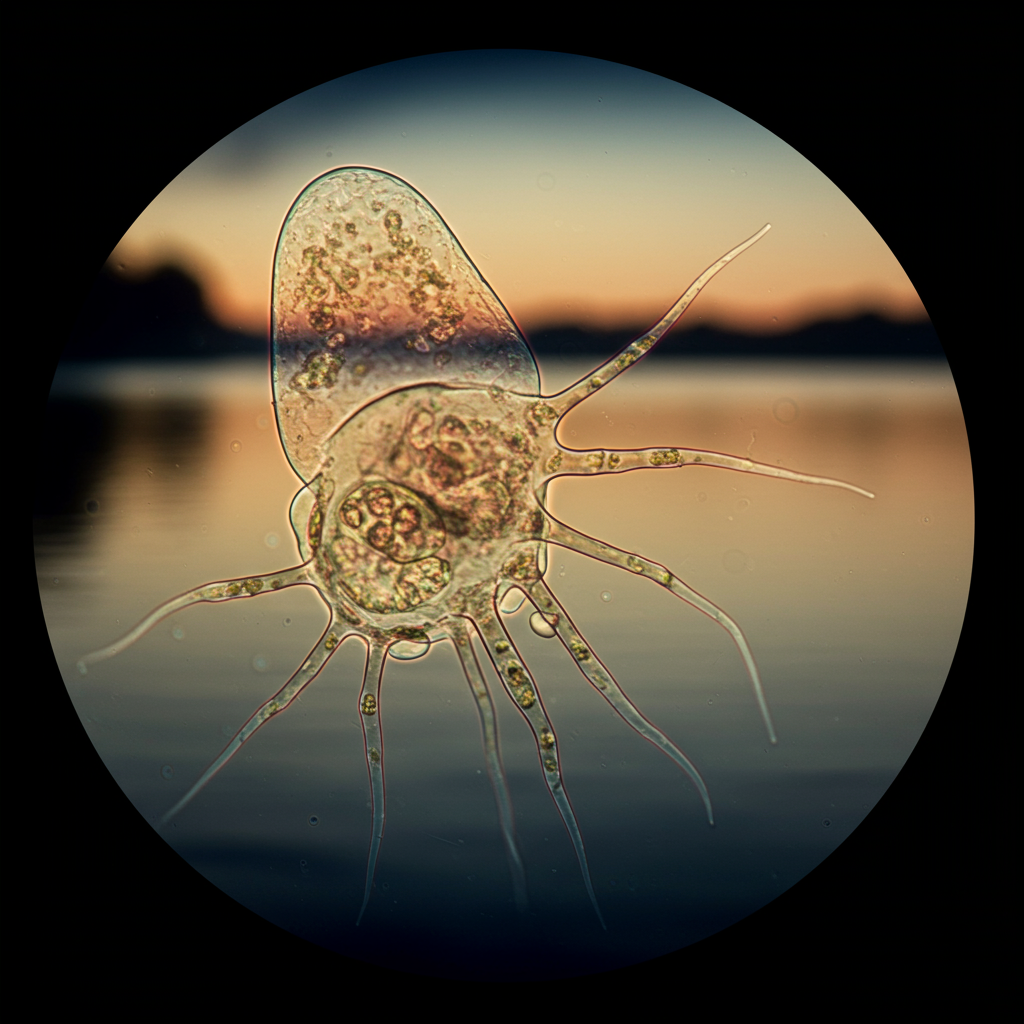A recent tragedy in South Carolina has brought a rare but deadly threat to the forefront: the brain-eating amoeba. A patient, whose identity remains private, tragically succumbed to a swift and severe brain infection after likely exposure at Lake Murray. This devastating incident, confirmed by Prisma Health Children’s Hospital-Midlands, serves as a stark reminder of the unique dangers lurking in warm freshwater environments. Understanding this microscopic organism, its risks, and how to stay safe is crucial for anyone enjoying recreational water activities.
Understanding the Brain-Eating Amoeba: Naegleria fowleri
Naegleria fowleri is a microscopic, single-celled organism naturally found in warm freshwater bodies. Often referred to as the “brain-eating amoeba,” it causes a devastating and nearly always fatal brain infection known as Primary Amebic Meningoencephalitis (PAM). While exposure to the amoeba is common, infection is exceedingly rare. This paradox—widespread presence but infrequent infection—is a key aspect of public health messaging around the organism.
The Mechanism of a Deadly Infection
Unlike common waterborne illnesses, Naegleria fowleri does not cause harm if swallowed. Infection occurs exclusively when water containing the amoeba forcefully enters the nose. This allows the organism to travel up the nasal passages, through the olfactory nerve, and into the brain. Once in the brain, it causes severe inflammation and destruction of brain tissue, leading to the rapid onset of PAM. This unique entry pathway is why prevention efforts focus heavily on nasal protection.
The Lake Murray Tragedy: A South Carolina Case
The recent fatality in South Carolina marks a somber moment for the state. Prisma Health Children’s Hospital-Midlands confirmed the patient’s death from PAM. Health officials, including the South Carolina Department of Public Health (SCDPH), suspect exposure occurred at Lake Murray in early July. This incident is the first confirmed case of Naegleria fowleri infection in South Carolina since 2016, highlighting its extreme rarity within the state.
Official Response and Public Reassurance
Despite the tragic outcome, state health officials like Dr. Linda Bell, South Carolina State Epidemiologist, have emphasized the overall low risk to the general public. Dr. Bell notes that with approximately ten cases reported annually nationwide, recreational water activities remain generally safe. Naegleria fowleri is naturally occurring in almost all warm freshwater. Due to its widespread natural presence, state agencies do not mandate testing for the amoeba, nor can they implement public health interventions to eradicate it from water bodies. The focus shifts to individual precautions.
Recognizing the Signs: Symptoms of PAM
The symptoms of Primary Amebic Meningoencephalitis (PAM) are severe and progress rapidly. Early symptoms typically appear within one to seven days after exposure. These often include a sudden, severe headache, high fever, nausea, and vomiting. A stiff neck is also a common initial indicator.
Rapid Progression and Critical Care
As the infection progresses, the patient’s condition quickly deteriorates. Later symptoms can involve confusion, a significant loss of attention, loss of balance, seizures, and even hallucinations. The disease’s progression is notoriously swift, with many patients succumbing to the infection within five days of symptom onset. Death often occurs within 1 to 18 days after symptoms first appear. Given this rapid and devastating course, prompt medical attention is crucial, though treatment options remain very limited and often unsuccessful. More than 97% of reported U.S. cases since the 1960s have been fatal.
Essential Precautions: Protecting Yourself from Infection
While rare, the severe consequences of Naegleria fowleri infection make prevention paramount. The Centers for Disease Control and Prevention (CDC) provides clear guidelines to minimize risk, particularly during recreational water activities in warm freshwater during hot summer months. These simple steps can make a significant difference in safeguarding your health.
Smart Habits for Water Safety
When enjoying lakes, rivers, or hot springs, several precautions can help prevent the amoeba from entering the nose. Firstly, always hold your nose shut or wear a nose clip when jumping, diving, or putting your head underwater. This prevents water from being forcefully pushed into the nasal passages. Secondly, try to keep your head above water, especially in hot springs where amoeba concentrations might be higher. Avoid stirring up sediment in shallow areas, as Naegleria fowleri often resides in the mud or sand at the bottom of water bodies.
Beyond Recreational Waters: Nasal Rinsing Safety
It is vital to note that Naegleria fowleri infections have also occurred from sources other than natural freshwater. A tragic case in Texas, for example, involved a woman who contracted the infection after using tap water from her RV in a nasal irrigation device. This highlights another critical preventive measure: when rinsing sinuses or cleansing nasal passages, always use distilled, sterile, or previously boiled tap water. Never use untreated tap water for these purposes. Importantly, PAM cannot be transmitted from person to person.
Broader Context: Rarity vs. Severity
The balance between the extreme rarity of Naegleria fowleri infections and their near-universal fatality is a complex public health challenge. With only 167 cases reported in the United States over the past 62 years, the chance of contracting PAM is incredibly low. State health officials emphasize this low incidence rate to avoid widespread panic, yet they also underscore the importance of individual vigilance due to the infection’s devastating outcome. The amoeba thrives in temperatures up to 115 degrees Fahrenheit (46 degrees Celsius), making warm summer conditions and lower water levels prime environments.
Why Public Health Cannot Eliminate the Threat
Given that Naegleria fowleri is a naturally occurring organism found in virtually all warm freshwater environments, public health agencies face significant limitations. There are no feasible public health interventions to eradicate the amoeba from natural water bodies. Therefore, the responsibility for prevention largely falls on individuals practicing smart water safety habits. Knowing the specific conditions under which infection occurs—forceful nasal entry—is key to implementing effective personal precautions.
Frequently Asked Questions
What exactly is Naegleria fowleri, and why is it so dangerous yet rare?
Naegleria fowleri is a microscopic, single-celled amoeba naturally found in warm freshwater environments. It is often called the “brain-eating amoeba” because it can cause Primary Amebic Meningoencephalitis (PAM), a severe and almost universally fatal brain infection. It is dangerous because it destroys brain tissue, but infections are extremely rare, with fewer than 10 cases typically reported annually in the U.S. This rarity, despite the amoeba’s widespread presence, is due to the specific, unusual way infection occurs: forceful entry into the nose, not by swallowing contaminated water.
Given its presence in places like Lake Murray, what are the most effective ways to prevent a brain-eating amoeba infection?
To prevent infection in warm freshwater bodies like Lake Murray, the Centers for Disease Control and Prevention (CDC) recommends several precautions. The most critical is to prevent water from forcefully entering your nose. This means holding your nose or wearing a nose clip when jumping, diving, or submerging your head. You should also try to keep your head above water in hot springs and avoid disturbing sediment in shallow areas, as the amoeba often lives in the mud at the bottom.
What are the key symptoms of a Naegleria fowleri infection, and how quickly do they develop?
Symptoms of a Naegleria fowleri infection (PAM) typically begin one to seven days after exposure. Initial signs include a severe headache, high fever, nausea, vomiting, and a stiff neck. As the infection progresses rapidly, later symptoms can involve confusion, loss of attention or balance, seizures, and hallucinations. The disease advances quickly, often leading to coma and death within one to eighteen days of symptom onset, with many fatalities occurring within five days. Immediate medical attention is vital if these symptoms appear after freshwater exposure.
Final Thoughts on Water Safety
The tragic death connected to Lake Murray underscores the critical need for awareness regarding Naegleria fowleri. While such infections remain incredibly rare, their devastating impact demands vigilance. By understanding how the amoeba operates and implementing simple, effective preventive measures—especially concerning nasal protection in warm freshwater—individuals can significantly reduce their minimal risk. Enjoying our beautiful natural waters can remain safe and enjoyable with proper knowledge and precaution.




